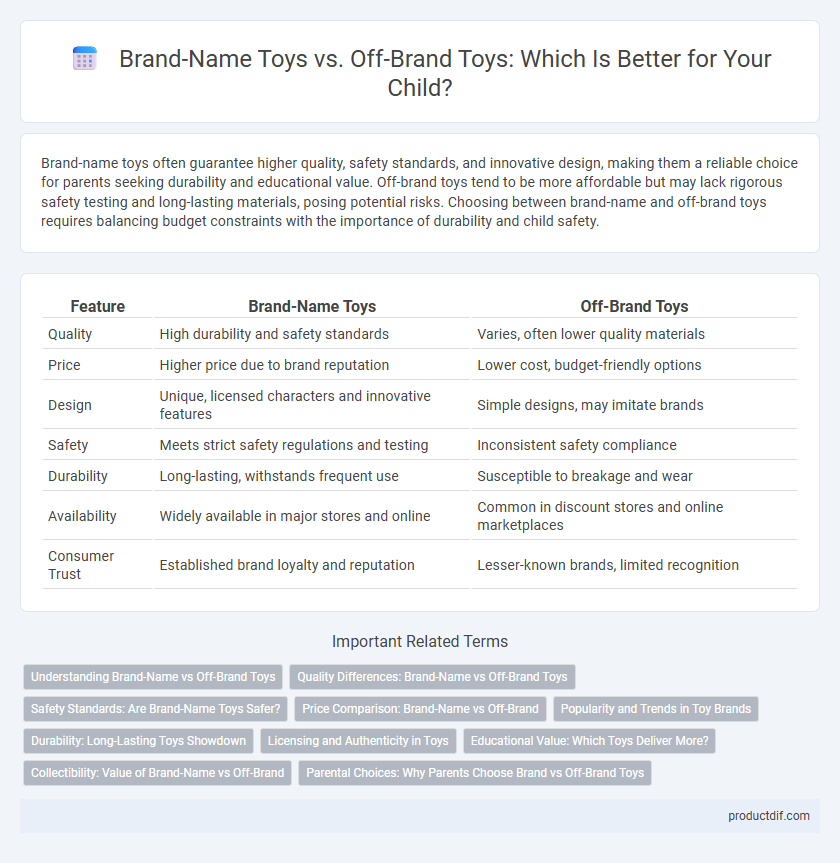Brand-name toys often guarantee higher quality, safety standards, and innovative design, making them a reliable choice for parents seeking durability and educational value. Off-brand toys tend to be more affordable but may lack rigorous safety testing and long-lasting materials, posing potential risks. Choosing between brand-name and off-brand toys requires balancing budget constraints with the importance of durability and child safety.
Table of Comparison
| Feature | Brand-Name Toys | Off-Brand Toys |
|---|---|---|
| Quality | High durability and safety standards | Varies, often lower quality materials |
| Price | Higher price due to brand reputation | Lower cost, budget-friendly options |
| Design | Unique, licensed characters and innovative features | Simple designs, may imitate brands |
| Safety | Meets strict safety regulations and testing | Inconsistent safety compliance |
| Durability | Long-lasting, withstands frequent use | Susceptible to breakage and wear |
| Availability | Widely available in major stores and online | Common in discount stores and online marketplaces |
| Consumer Trust | Established brand loyalty and reputation | Lesser-known brands, limited recognition |
Understanding Brand-Name vs Off-Brand Toys
Brand-name toys often guarantee higher quality materials, safety standards, and durability due to rigorous testing and established manufacturing processes. Off-brand toys may offer lower prices but can vary widely in quality, safety certifications, and design precision, posing potential risks. Consumers prioritize brand reputation and verified safety ratings to ensure value and child safety in toy selection.
Quality Differences: Brand-Name vs Off-Brand Toys
Brand-name toys often undergo rigorous safety testing and use higher-quality materials, resulting in greater durability and safer play experiences compared to off-brand toys. Off-brand toys may lack consistent quality control, leading to potential safety hazards and shorter lifespans. Investing in brand-name toys reduces the risk of defects and ensures compliance with industry safety standards like ASTM F963 and CPSIA.
Safety Standards: Are Brand-Name Toys Safer?
Brand-name toys typically adhere to strict safety standards and undergo rigorous testing to meet regulations such as ASTM F963 and CPSIA, ensuring they are less likely to contain harmful materials or pose choking hazards. Off-brand toys often lack comprehensive safety certification, increasing the risk of exposure to toxic substances like lead or unregulated small parts. Prioritizing brand-name toys can significantly reduce safety risks and protect children from potential injuries caused by substandard manufacturing processes.
Price Comparison: Brand-Name vs Off-Brand
Brand-name toys typically cost 20-50% more than off-brand alternatives due to licensing fees and marketing expenses. Off-brand toys often offer similar features and quality at a lower price, appealing to budget-conscious consumers. Price sensitivity drives many parents to choose off-brand options without significantly compromising on safety or entertainment value.
Popularity and Trends in Toy Brands
Brand-name toys consistently dominate the market due to strong brand recognition and extensive marketing campaigns that influence consumer preferences. Popular trends show that kids and parents often gravitate towards iconic brands like LEGO, Barbie, and Hot Wheels, which are perceived as more reliable and innovative. Off-brand toys compete primarily on price but struggle to match the widespread popularity and trendsetting appeal of established toy brands.
Durability: Long-Lasting Toys Showdown
Brand-name toys often use higher-quality materials and undergo rigorous safety testing, resulting in enhanced durability that withstands rough play and lasts longer. Off-brand toys, while typically more affordable, may sacrifice material strength and craftsmanship, leading to faster wear and breakage. Investing in brand-name toys can provide better long-term value due to their superior construction and resistance to damage.
Licensing and Authenticity in Toys
Brand-name toys often secure official licenses from popular franchises, ensuring authenticity and appeal by featuring true-to-character designs and quality standards. Licensed toys provide consumers with trusted merchandise that mirrors the original media, enhancing play value and collector interest. In contrast, off-brand toys may lack official licensing, resulting in generic or imitation products that risk inferior craftsmanship and diminished brand recognition.
Educational Value: Which Toys Deliver More?
Brand-name toys like LEGO and Melissa & Doug often deliver higher educational value through carefully designed features that promote creativity, problem-solving, and fine motor skills development. Off-brand toys may offer similar play possibilities but frequently lack the rigorous safety testing and instructional quality that enhance learning outcomes. Educational specialists recommend brand-name toys for structured skill-building due to their proven cognitive and developmental benefits.
Collectibility: Value of Brand-Name vs Off-Brand
Brand-name toys retain higher collectibility due to their established reputation, limited editions, and official licensing, which drive up their market value over time. Off-brand toys often lack authenticity and detailed craftsmanship, resulting in lower demand and diminished resale prices among collectors. Collectors prioritize brand-name toys for their rarity, quality, and historical significance, making them more desirable assets in the toy market.
Parental Choices: Why Parents Choose Brand vs Off-Brand Toys
Parents often choose brand-name toys for their proven safety standards, durability, and trusted quality, ensuring a reliable play experience for their children. Off-brand toys attract parents seeking more affordable options without sacrificing variety, appealing to budget-conscious families. Reviews, certifications, and personal experiences heavily influence parental decisions between brand-name and off-brand toys.
Brand-name toys vs off-brand toys Infographic

 productdif.com
productdif.com